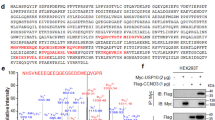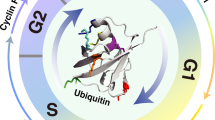Abstract
Understanding of molecular mechanisms underlying the effects of cell cycle proteins in response to the chemotherapeutic agents is of great importance for improving the efficacy of targeted therapeutics and overcoming resistance to chemotherapeutic agents. Staurosporine and tumor necrosis factor alpha (TNFα) are the therapeutic agents that inhibit tumor cell growth by inducing cell death. Staurosporine induces apoptosis through the intrinsic pathway, while TNFα trigger the cell death via the extrinsic apoptotic pathway. We have previously demonstrated that the cell cycle regulatory protein, cyclin A1 played an important role in the development of acute myeloid leukemia (AML), and cyclin A1 expression correlated with disease characteristics and patient outcome in leukemia. However, it remains unknown how cyclin A1 expression is regulated in leukemic cells treated with the therapeutic agents. Here, we demonstrate that cyclin A1 protein is regulated by proteasome-mediated ubiquitination and degradation in untreated U-937 cells. Interestingly, ubiquitination- and proteasomal-mediated degradation of cyclin A1 is prevented in cells treated with staurosporine or TNFα. Induction of apoptosis in U-937 cells by staurosporine or TNFα resulted in an increase in cyclin A1 protein expression, which correlated well with cyclin A1 protein modification and the activation of caspase-3. Blocking caspases activity by Z-VAD-FMK had no effect on the increased cyclin A1 expression, suggesting that cyclin A1 might be regulated by caspase-3 independent pathways. We further propose that CDC25C may be associated with cyclin A1 protein modification in response to staurosporine or TNFα treatment. Our results suggest that cyclin A1 protein is stabilized via post-transcriptional modification in response to apoptosis induced by staurosporine or TNFα.






Similar content being viewed by others
Abbreviations
- TNFα:
-
Tumor necrosis factor alpha
- AML:
-
Acute myeloid leukemia
- ALL:
-
Lymphoblastic leukemia
- ATRA:
-
All-trans retinoic acid
- CHX:
-
Cycloheximide
References
Bartek J, Lukas J (2001) Pathways governing G1/S transition and their response to DNA damage. FEBS Lett 490:117–122. doi:10.1016/S0014-5793(01)02114-7
Winston JT, Chu C, Harper JW (1999) Culprits in the degradation of cyclin E apprehended. Genes Dev 13:2751–2757. doi:10.1101/gad.13.21.2751
Winston JT, Strack P, Beer-Romero P, Chu CY, Elledge SJ, Harper JW (1999) The SCFbeta-TRCP-ubiquitin ligase complex associates specifically with phosphorylated destruction motifs in IkappaBalpha and beta-catenin and stimulates IkappaBalpha ubiquitination in vitro. Genes Dev 13:270–283. doi:10.1101/gad.13.3.270
Porter PL, Malone KE, Heagerty PJ, Alexander GM, Gatti LA, Firpo EJ et al (1997) Expression of cell-cycle regulators p27Kip1 and cyclin E, alone and in combination, correlate with survival in young breast cancer patients. Nat Med 3:222–225. doi:10.1038/nm0297-222
Passegue E, Jamieson CH, Ailles LE, Weissman IL (2003) Normal and leukemic hematopoiesis: are leukemias a stem cell disorder or a reacquisition of stem cell characteristics? Proc Natl Acad Sci USA 100(Suppl 1):11842–11849. doi:10.1073/pnas.2034201100
Gross A, McDonnell JM, Korsmeyer SJ (1999) BCL-2 family members and the mitochondria in apoptosis. Genes Dev 13:1899–1911. doi:10.1101/gad.13.15.1899
Martinou JC, Green DR (2001) Breaking the mitochondrial barrier. Nat Rev Mol Cell Biol 2:63–67. doi:10.1038/35048069
Gross A et al (1999) Caspase cleaved BID targets mitochondria and is required for cytochrome c release, while BCL-XL prevents this release but not tumor necrosis factor-R1/Fas death. J Biol Chem 274:1156–1163. doi:10.1074/jbc.274.2.1156
Gupta S (2003) Molecular signaling in death receptor and mitochondrial pathways of apoptosis. Int J Oncol 22:15–20 (Review)
Pucci B, Kasten M, Giordano A (2000) Cell cycle and apoptosis. Neoplasia 2:291–299. doi:10.1038/sj.neo.7900101
Vermeulen K, Berneman ZN, Van Bockstaele DR (2003) Cell cycle and apoptosis. Cell Prolif 36:165–175. doi:10.1046/j.1365-2184.2003.00267.x
Harvey KJ, Blomquist JF, Ucker DS (1998) Commitment and effector phases of the physiological cell death pathway elucidated with respect to Bcl-2 caspase, and cyclin-dependent kinase activities. Mol Cell Biol 18:2912–2922
Ling YH, Consoli U, Tornos C, Andreeff M, Perez-Soler R (1998) Accumulation of cyclin B1, activation of cyclin B1-dependent kinase and induction of programmed cell death in human epidermoid carcinoma KB cells treated with taxol. Int J Cancer 75:925–932. doi:10.1002/(SICI)1097-0215(19980316)75:6<925::AID-IJC16>3.0.CO;2-1
Meikrantz W, Gisselbrecht S, Tam SW, Schlegel R (1994) Activation of cyclin A-dependent protein kinases during apoptosis. Proc Natl Acad Sci USA 91:3754–3758. doi:10.1073/pnas.91.9.3754
Han EK, Begemann M, Sgambato A, Soh JW, Doki Y, Xing WQ et al (1996) Increased expression of cyclin D1 in a murine mammary epithelial cell line induces p27kip1, inhibits growth, and enhances apoptosis. Cell Growth Differ 7:699–710
Kranenburg O, van der Eb AJ, Zantema A (1996) Cyclin D1 is an essential mediator of apoptotic neuronal cell death. EMBO J 15:46–54
Yang R, Muller C, Huynh V, Fung YK, Yee AS, Koeffler HP (1999) Functions of cyclin A1 in the cell cycle and its interactions with transcription factor E2F-1 and the Rb family of proteins. Mol Cell Biol 19:2400–2407
Yang R et al (1999) Cyclin A1 expression in leukemia and normal hematopoietic cells. Blood 93:2067–2074
Liu D, Matzuk MM, Sung WK, Guo Q, Wang P, Wolgemuth DJ (1998) Cyclin A1 is required for meiosis in the male mouse. Nat Genet 20:377–380. doi:10.1038/3855
Ji P et al (2005) Cyclin A1, the alternative A-type cyclin, contributes to G1/S cell cycle progression in somatic cells. Oncogene 24:2739–2744. doi:10.1038/sj.onc.1208356
Liao C, Wang XY, Wei HQ, Li SQ, Merghoub T, Pandolfi PP et al (2001) Altered myelopoiesis and the development of acute myeloid leukemia in transgenic mice overexpressing cyclin A1. Proc Natl Acad Sci USA 98:6853–6858. doi:10.1073/pnas.121540098
Ekberg J, Holm C, Jalili S, Richter J, Anagnostaki L, Landberg G et al (2005) Expression of cyclin A1 and cell cycle proteins in hematopoietic cells and acute myeloid leukemia and links to patient outcome. Eur J Haematol 75:106–115. doi:10.1111/j.1600-0609.2005.00473.x
Holm C, Ora I, Brunhoff C, Anagnostaki L, Landberg G, Persson JL (2006) Cyclin A1 expression and associations with disease characteristics in childhood acute lymphoblastic leukemia. Leuk Res 30:254–261. doi:10.1016/j.leukres.2005.07.010
Ekberg J, Landberg G, Holm C, Richter J, Wolgemuth DJ, Persson JL (2004) Regulation of the cyclin A1 protein is associated with its differential subcellular localization in hematopoietic and leukemic cells. Oncogene 23:9082–9089. doi:10.1038/sj.onc.1208090
Ekberg J, Brunhoff C, Jaras M, Fan X, Landberg G, Persson JL (2006) Increased expression of cyclin A1 protein is associated with all-trans retinoic acid-induced apoptosis. Int J Biochem Cell Biol 38:1330–1339. doi:10.1016/j.biocel.2006.01.011
Glotzer M, Murray AW, Kirschner MW (1991) Cyclin is degraded by the ubiquitin pathway. Nature 349:132–138. doi:10.1038/349132a0
Wallach D, Boldin M, Varfolomeev E, Beyaert R, Vandenabeele P, Fiers W (1997) Cell death induction by receptors of the TNF family: towards a molecular understanding. FEBS Lett 410:96–106. doi:10.1016/S0014-5793(97)00553-X
Gadbois DM, Crissman HA, Tobey RA, Bradbury EM (1992) Multiple kinase arrest points in the G1 phase of nontransformed mammalian cells are absent in transformed cells. Proc Natl Acad Sci USA 89:8626–8630. doi:10.1073/pnas.89.18.8626
Tamaoki T (1991) Use and specificity of staurosporine, UCN-01, and calphostin C as protein kinase inhibitors. Meth Enzymol 201:340–347. doi:10.1016/0076-6879(91)01030-6
Edamatsu H, Gau CL, Nemoto T, Guo L, Tamanoi F (2000) Cdk inhibitors, roscovitine and olomoucine, synergize with farnesyltransferase inhibitor (FTI) to induce efficient apoptosis of human cancer cell lines. Oncogene 19:3059–3068. doi:10.1038/sj.onc.1203625
Yew PR (2001) Ubiquitin-mediated proteolysis of vertebrate G1- and S-phase regulators. J Cell Physiol 187:1–10. doi:10.1002/1097-4652(2001)9999:9999<1::AID-JCP1049>3.0.CO;2-O
Sudakin V, Ganoth D, Dahan A, Heller H, Hershko J, Luca FC et al (1995) The cyclosome, a large complex containing cyclin-selective ubiquitin ligase activity, targets cyclins for destruction at the end of mitosis. Mol Biol Cell 6:185–197
Tyers M, Jorgensen P (2000) Proteolysis and the cell cycle: with this RING I do thee destroy. Curr Opin Genet Dev 10:54–64. doi:10.1016/S0959-437X(99)00049-0
Bernardi R, Pandolfi PP (2003) Role of PML and the PML-nuclear body in the control of programmed cell death. Oncogene 22:9048–9057. doi:10.1038/sj.onc.1207106
Jin Y, Blue EK, Dixon S, Hou L, Wysolmerski RB, Gallagher PJ (2001) Identification of a new form of death-associated protein kinase that promotes cell survival. J Biol Chem 276:39667–39678. doi:10.1074/jbc.M101886200
Wang ZG, Ruggero D, Ronchetti S, Zhong S, Gaboli M, Rivi R et al (1998) PML is essential for multiple apoptotic pathways. Nat Genet 20:266–272. doi:10.1038/3030
Zhang HG, Wang J, Yang X, Hsu HC, Mountz JD (2004) Regulation of apoptosis proteins in cancer cells by ubiquitin. Oncogene 23:2009–2015. doi:10.1038/sj.onc.1207373
Shimizu T, O’Connor PM, Kohn KW, Pommier Y (1995) Unscheduled activation of cyclin B1/Cdc2 kinase in human promyelocytic leukemia cell line HL60 cells undergoing apoptosis induced by DNA damage. Cancer Res 55:228–231
Inoue T, Geyer RK, Howard D, Yu ZK, Maki CG (2001) MDM2 can promote the ubiquitination, nuclear export, and degradation of p53 in the absence of direct binding. J Biol Chem 276:45255–45260. doi:10.1074/jbc.M107477200
Shieh SY, Ikeda M, Taya Y, Prives C (1997) DNA damage-induced phosphorylation of p53 alleviates inhibition by MDM2. Cell 91:325–334. doi:10.1016/S0092-8674(00)80416-X
Boutros R, Lobjois V, Ducommun B (2007) CDC25 phosphatases in cancer cells: key players? Good targets? Nat Rev Cancer 7:495–507. doi:10.1038/nrc2169
Acknowledgments
This work was supported by the Swedish National Research Council, the Swedish Cancer Society, the Swedish Children Cancer Foundation, MAS Cancer Foundation, Kunglig Fysiografisk Sällskapet in Lund, Crafoordska stiftelsen, and MAS Foundation, Gunnar Nilsson Cancer Foundation, the Government Public Health Grant (ALF), and the Medical Faculty in Lund University. We thank Cecilia Brunhoff, Elise Nilsson, and Temesgen Fufa for their technical assistance and Dr. Debra Wolgemuth for valuable suggestions.
Author information
Authors and Affiliations
Corresponding author
Rights and permissions
About this article
Cite this article
Ekberg, J., Persson, J.L. Post-translational modification of cyclin A1 is associated with staurosporine and TNFα induced apoptosis in leukemic cells. Mol Cell Biochem 320, 115–124 (2009). https://doi.org/10.1007/s11010-008-9913-3
Received:
Accepted:
Published:
Issue Date:
DOI: https://doi.org/10.1007/s11010-008-9913-3




